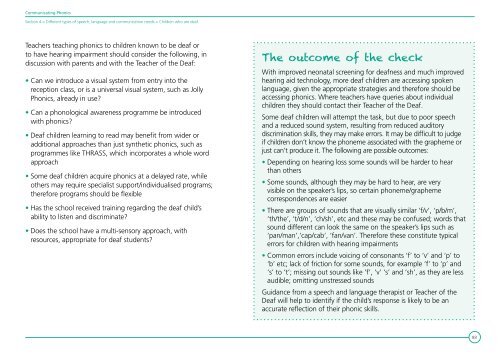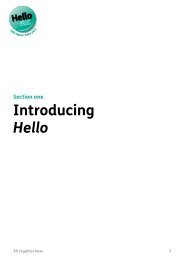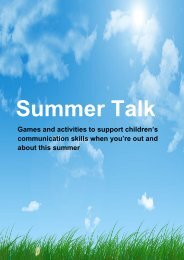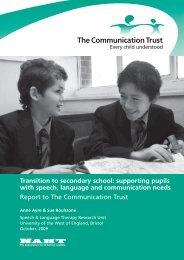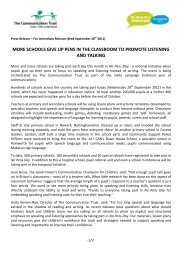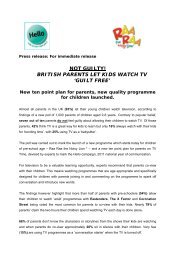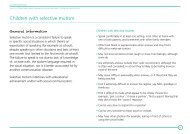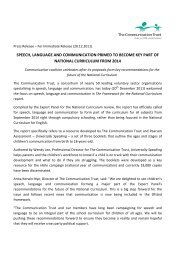Communicating Phonics - The Communication Trust
Communicating Phonics - The Communication Trust
Communicating Phonics - The Communication Trust
Create successful ePaper yourself
Turn your PDF publications into a flip-book with our unique Google optimized e-Paper software.
<strong>Communicating</strong> <strong>Phonics</strong>Section 4 > Different types of speech, language and communication needs > Children who are deafTeachers teaching phonics to children known to be deaf orto have hearing impairment should consider the following, indiscussion with parents and with the Teacher of the Deaf:• Can we introduce a visual system from entry into thereception class, or is a universal visual system, such as Jolly<strong>Phonics</strong>, already in use?• Can a phonological awareness programme be introducedwith phonics?• Deaf children learning to read may benefit from wider oradditional approaches than just synthetic phonics, such asprogrammes like THRASS, which incorporates a whole wordapproach• Some deaf children acquire phonics at a delayed rate, whileothers may require specialist support/individualised programs;therefore programs should be flexible• Has the school received training regarding the deaf child’sability to listen and discriminate?• Does the school have a multi-sensory approach, withresources, appropriate for deaf students?<strong>The</strong> outcome of the checkWith improved neonatal screening for deafness and much improvedhearing aid technology, more deaf children are accessing spokenlanguage, given the appropriate strategies and therefore should beaccessing phonics. Where teachers have queries about individualchildren they should contact their Teacher of the Deaf.Some deaf children will attempt the task, but due to poor speechand a reduced sound system, resulting from reduced auditorydiscrimination skills, they may make errors. It may be difficult to judgeif children don’t know the phoneme associated with the grapheme orjust can’t produce it. <strong>The</strong> following are possible outcomes:• Depending on hearing loss some sounds will be harder to hearthan others• Some sounds, although they may be hard to hear, are veryvisible on the speaker’s lips, so certain phoneme/graphemecorrespondences are easier• <strong>The</strong>re are groups of sounds that are visually similar ‘f/v’, ‘p/b/m’,‘th/the’, ‘t/d/n’, ‘ch/sh’, etc and these may be confused; words thatsound different can look the same on the speaker’s lips such as‘pan/man’,‘cap/cab’, ‘fan/van’. <strong>The</strong>refore these constitute typicalerrors for children with hearing impairments• Common errors include voicing of consonants ‘f’ to ‘v’ and ‘p’ to‘b’ etc; lack of friction for some sounds, for example ‘f’ to ‘p’ and‘s’ to ‘t’; missing out sounds like ‘f’, ‘v’ ‘s’ and ‘sh’, as they are lessaudible; omitting unstressed soundsGuidance from a speech and language therapist or Teacher of theDeaf will help to identify if the child’s response is likely to be anaccurate reflection of their phonic skills.83


